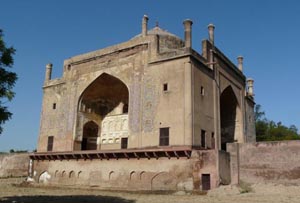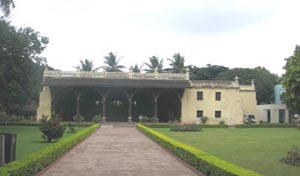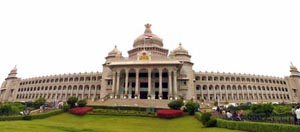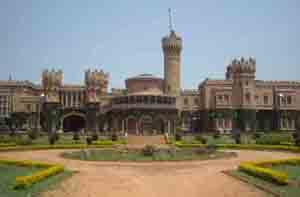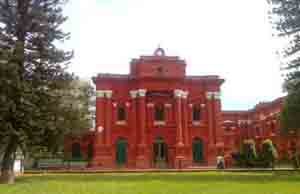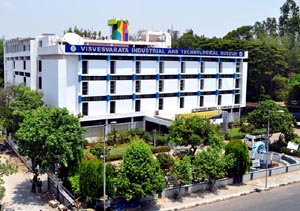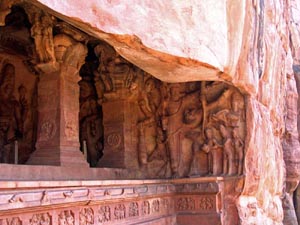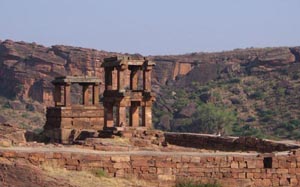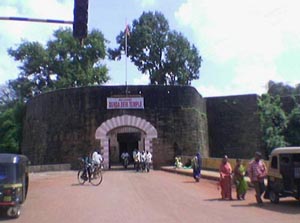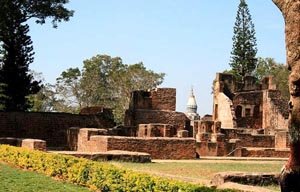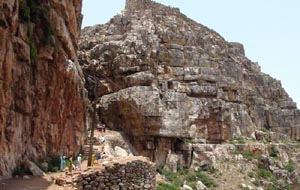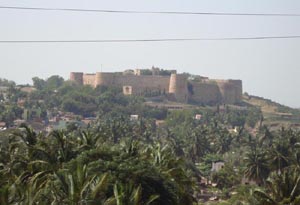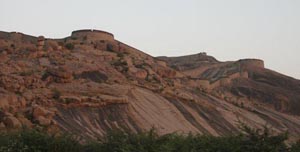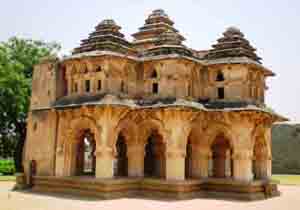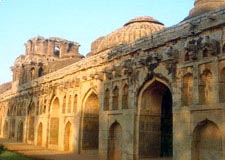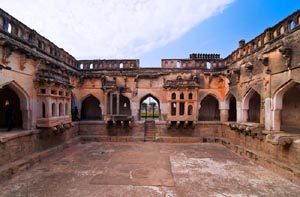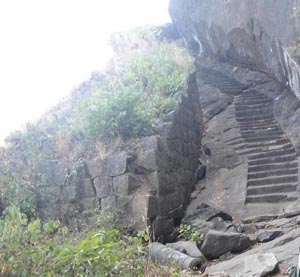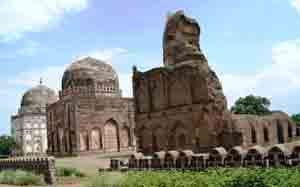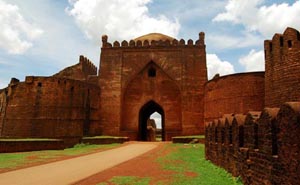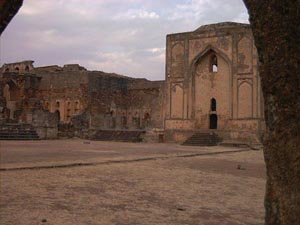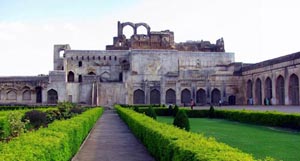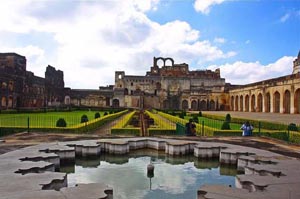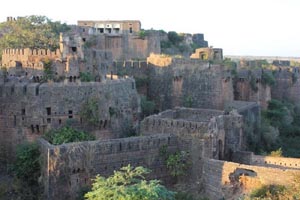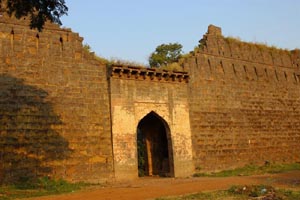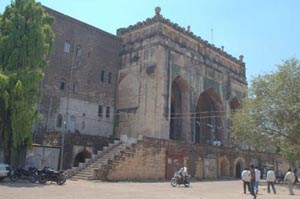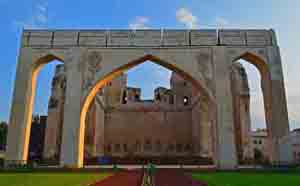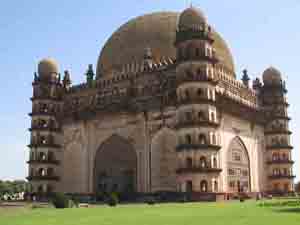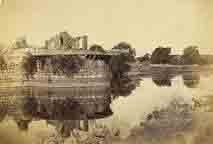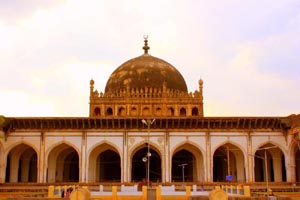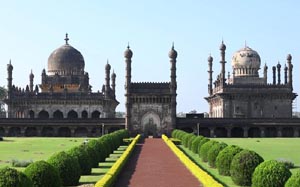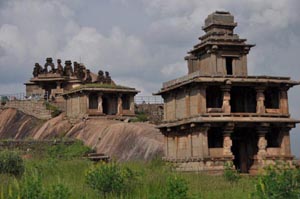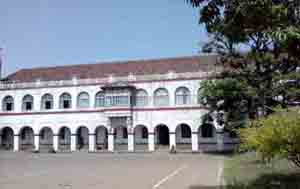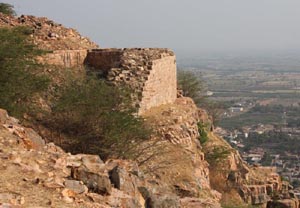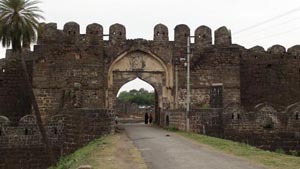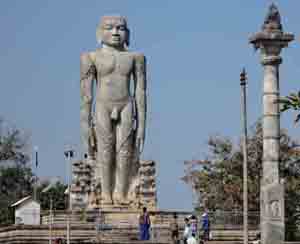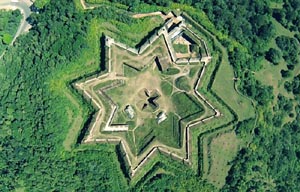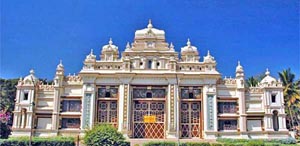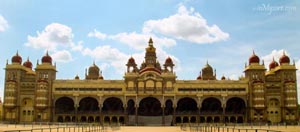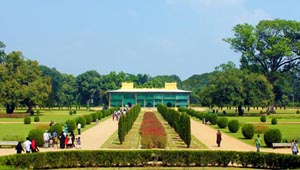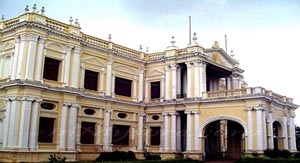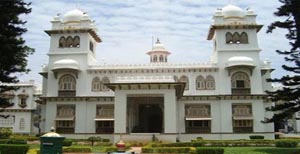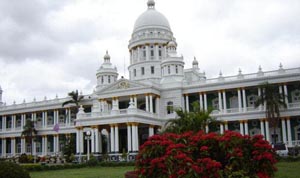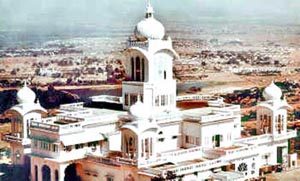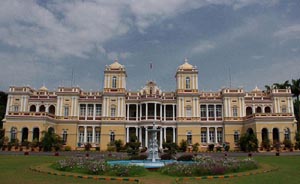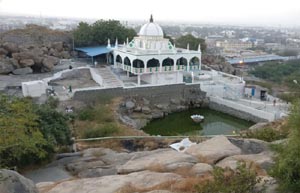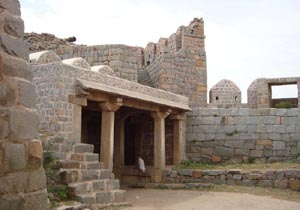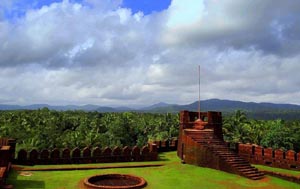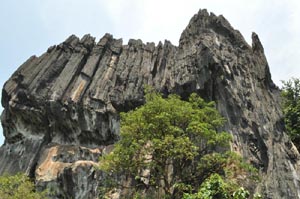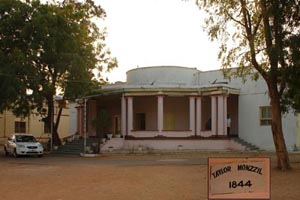Karnataka Monuments - Famous Historical Places, Forts & Palaces
List of names of Famous Historical Forts / Palaces / Places of Karnataka State
Here you can find list of names and information on historical forts / palaces/ places / monuments in Karnataka, India. These famous monuments of Karnataka state are most visited and most sought after best tourist places. You can also find images of Karnataka monuments / places / forts / palaces.
Bangalore Monuments, Karnataka »
Afzal Khan's Cenotaphs is regarded as an amazing monument of Indian history. It is situated in Bijapur of Karnataka and is believed that Afzal Khan initiated the structure of his own catacomb throughout his life span. However, at the end, Afzal Khan himself could not be buried there. Significant historical story is related with this monument which makes this place highly important for the purpose of travelling.
The architectural beauty of the fort has influenced the state government of Karnataka to use the fort for tourism purposes. The fort which was a two storied monument was mainly constructed with the extensive use of stone and mud. The construction of the structure also used teak to make some parts of the pillars and the arches. Notably, there were primarily four rooms the first floor of the monument which was used in the corners of first floor which were mainly used to accommodate women and was termed as Zenana quarters.
Vidhana Soudha is the name of a particular building located in Bengaluru, India. Constructed in 1956, the building serves as the seat of legislative assembly for the government of the state of Karnataka. In terms of its look, the building is quite grand owing to its architectural beauty. It style is often described to be relevant to Neo-Dravidian and is been constructed following the approach of the Indo-Saracenic elements.
Bangalore Palace was established in Tudor style architecture. The inner designs of Bangalore Palace are decorated with sophisticated statues, flowery themes, cornices and images on the ceilings. The palace has neoclassical, Victorian and Edwardian designed furniture. It has about 35 deluxe rooms. The ground floor of Bangalore Palace include a huge yard which comprise granite seats.
Govt Museum Bangalore is regarded as one of the oldest museums in India. It is situated in Kasturba Gandhi Road of Bangalore, Karnataka. The present central structure of the museum was created in the year 1876 by Colonel Richard Hieram Sankey. In later phases, multiple sections were added to the central structure of Govt Museum Bangalore.
Technological Museum found in Bangalore is also called as the Visvesvaraya Industrial and Technological Museum (VITM). This is dedicated to the Indian legend in the field of Engineering named M. Vishvesvaraya (1861 Ad to 1962 Ad). All his masterpiece engineering works are put on display here. It is located at Kasthurbha Rod, Bangalore City of Karnataka State in India.
Bagalkot Monuments, Karnataka »
Badami Caves is a temple which is situated in Badami of Karnataka, near red sandstone point. Badami Caves comprise four caves which are created from lenient stonework on a hill crag in the late 6th century. These caves have simple design, having gateway with stone supports and brackets. The unique characteristics of Badami Caves regarded as a great place for tourism. The caves signify diverse religious groups.
The Badami North Fort is situated in the district of Bagalkot, North Karnataka. Badami is a small town which was previously referred to as Vatapi. It used to be the royal capital city of the Badami Chalukya rulers from the period of 540 to 757 A.D. The town is renowned for its rich historical monuments as well as beauty.
Belgaum Monuments, Karnataka »
Belgaum Fort is regarded as one of the oldest monuments of Belgaum of Karnataka. It is a key tourist attraction of Belgaum. It is placed at the slopes of Sahyadris which was traditionally denoted as 'bamboo village'. Sahyadris has a height of 762 meters above sea level and is located at about 100 kilometre distance from Arabian Sea. Develop with large walls and attractive architecture, Belgaum Fort has rich history with various memorials dated to Adil Shahi family.
The Kittur Chennamma Fort is considered to be a historical monument of great significance in Karnataka. Kittur is a small town in Belgaum District of Karnataka which enjoys a global reputation owing to the presence of the Kittur Chennamma Fort. The fort is located at a distance of about 50 kilometres from Belgaum and 32 kilometres away from Dharwad.
Parasgad Fort is a hill fort lies in the area of Saundatti in Belgaum district of Karnataka. It is a craggy and stony fort, which is positioned in the west brink of a mountain, directly overlooking the black soil plain down below. The hill where Parasgad Fort is situated, spread almost 500 meters from North to South and approximately 300 meters from East to West. The surrounding area of the fort is covered with grumpy pear and brushwood.
Saundatti Fort is situated within a distance of about 78 kilometre from Belgaum city of Karnataka. It is basically a Taluq which was traditionally termed as Parasgad. Saundatti Fort is a historical site which is characterised by many temples with various captions. It also possesses a water reservoir which has been formed by Navilathirtha dam on Malaprava River. Saundatti Fort is particularly congested during the promising event of 'Bharathi Hunime' and 'Banada Hunime'.
Bellary Monuments, Karnataka »
Bellary Fort was constructed by Hanumappa Nayaka, during the Vijayanagar Empire. The fort is to be found at the hilltop of the Ballari Gudda. The Fort was built encompassing the hill for the period of Vijayanagara by Hanumappa Nayaka. Shortly, Hyder Ali, took ownership of the Fort from the Nayaka family in 1769, and renovated and modified the fort with the assist of a French Engineer.
Lotus Mahal is located in zenana enclosure in the world heritage village of Hampi, in the district of Bellary, in the state of Karnataka, in South India. It is a beautiful palace for the queen. It is a well-planned residential structure that belongs to the later Vijayanagara period. Hampi is the present ruined capital city of the historic Vijayanagara Empire. In the Royal Centre of Vijayanagara, it is the best well-preserved courtly structure.
Though the gateway has its own beauty in terms of size and area covered, its prominent attraction is the well built door. The door has the extensive use of marbles and granite along with hard stones which further makes it a visual treat for the people. It is believed that it is largely due to the beauty of the door that the structure was made the entrance of the city by the rulers during the period ranging in between 14-15 century.
Queen's Bath is a man made pond by stones blocks on a plain land surface. It is built in the Indo Gothic form of architecture. This great bath was built by the Hindu rulers, but it does have an Islamic style of works in their arches. This type of mix was seen in the medieval times. The main importance of this bath is it is not seen from any of its side's areas. It is surrounded by a big compound on its all sides. Totally it looks like a rectangular structure meant for housing purpose.
Dakshina Kannada Monuments, Karnataka »
Jamalabad Fort is located in Killoor Road, Belthangady in the district of Dakshina Kannada, in the state of Karnataka in South India. It is an old hilltop fortification. In the Kudremukh range of hills, this Fort is situated. It is nearly 65 km from Mangalore, about 22km from Dharamstala and just 8 km from Beltangady. On a granite hill, this fort is built in a successful manner at a height of 1700 ft above sea level. It was called formerly as Narasimha Ghada.
Bidar Monuments, Karnataka »
Bahamani Tomb is huge condemned tombs of Bahamani kings. It is situated in Ashtur at 3 kilometre distance from Bidar of Karnataka. Bahamani Tomb has a deserted and temperamental attractiveness which strikes extraordinary synchronisation with the rolling mounts around them. This inspiring construction were established in order to house the remnants of sultans. Their tombs are still habitually wrapped with fresh satins and flowers and are arranged properly.
Bidar fort is situated in the district of Bidar, northern plateau of Karnataka, in India. The Fort was formerly built in 8th century furthermore strengthened and reconstructed in 1428 by Sultan Ahmad Shah Bahamani. The Bidar fort shows off with a dominating existence in the landscape of Bidar. Present within this entwined fort is the magnificent town scattered with degeneration shell of the bastions and the entrance.
The architecture of the building was influenced from the indo-Islamic style. The features within the interior of the Mahal have relevance with the modern day architecture. The Mahal had a hot water swimming pool which was carved with granite materials from all sides. The figures and portraits in the interior of the Mahal portray the influence of the Islamic architecture while the floral designs in the walls depict the texture of the Hindu architecture.
The Tarkash Mahal is in Bidar Fort and is located in the Bidar district of Karnataka. The fort though initially constructed by the Brahmins but the upper parts of the fort was completed during the reign of the Baridi. The construction of the fort was started in the 14th century and completed in the early 15th century. It is worth a visit owing to the architectural and historical heritage.
The Mahal depicts the artistic taste of the King of Bahmani and King Ali Barid. The architecture of the Mahal has a fusion of both the Hindu and Muslim art especially in the paintings and the decorations on the wall. Notably, traces remains within the Mahal suggested that aspects such as stone carving, stucco as well as floral work within interior of the Mahal are among magnificent feature of the monument. The interior of the hall has walls and ceilings which has the decoration of 'Mother of Pearl' along with mosaics.
Basavakalyan Fort which was also known as Kalyana Fort is situated in Bidar district of Karnataka. It was created by Chalukas in 10th century. Basavakalyan Fort has vital significance to Basavakalyan city, which is also famous for the originator of Virashaiva community. This fort was the core of great social and religious drive during 12th century. Many saints of Virashaiva community are related with Basavakalyan Fort.
Situated in old Bhalki town, Bhalki Fort is a specimen of historical importance of Karnataka. Bhalki Fort hosts variety of constructions which comprise Satyaniketan School, residential areas and temples among others. This fort is also termed as 'Gadi' which derived from the word 'Gad'. It is believed that Bhalki Fort was created by Ramachandra Jadhav and Dhanaji Jadhav between the years 1820 to 1850.
Bijapur Monuments, Karnataka »
Anand Mahal is regarded as one of the most important historical attractions of Bijapur city of Karnataka. Bijapur is a popular historical city of Karnataka and is considered as a treasure of Islamic architecture. It possess various famed memorials and one of them is Anand Mahal. It is situated at about 205 kilometre distance from Belgaum airport and about 530 kilometre towards the northwest side of Bangalore, the capital of Karnataka.
Gagan Mahal is a palace in combination with audience hall which is situated in Bijapur of Karnataka. It is one of the famous tourist attractions of Bijapur. The name of this monument was chosen due to its amazing view of the sky. Gagan Mahal is regarded as a delicate building with small yet stunningly decorated galleries, windows and sophisticated carvings.
Gol Gumbaz is the most popular memorial of Bijapur in Karnataka. It is basically a vault which is regarded as the second biggest dome in the world after St. Peter's Cathedral in Rome. Gol Gumbaz houses the catacomb of King Adil Shah. Legend states that this memorial was established by the orders of Adil Shah before his demise. It was the wish of Adil Shah to create a catacomb as a memorial which is comparable with his father Ibrahim Rauza.
Bijapur Fort is located in the district of Bijapur in the state of Karnataka, in south India. It is also known as Vijapur kote in Kanada language. It as built in a successful manner during the rule of Adil Shahi Dynasty. This particular fort largely has a plethora of historical monuments of architectural significance. It is to be remembered that for approximately 200 years, the Adil Shahi Sultans ruled this region.
Mehtar Mahal is located in the Bijapur fort in the district of Bijapur in the state of Karnataka in South India. It dates back to 1620, though it is sized modestly, it is one of the significant structures in this particular fort. In Indo-Saracenic style and pattern, the entry gate has been built. The domestic and foreign tourists visit the Bijapur Fort; they throng to visit the Mehtar Mahal because of its historical and architectural significance.
Ibrahim Roza is totally built in the Persian architectural pattern. It architect was Malik Sandal, who was a great architect in the 16th century. His contribution to Islamic structure is mostly found in the Bijapur City. This tomb was built here in the similar style of those structures found on the Taj Mahal. He may be thought to build similar structure here. This tomb is built in a beautiful garden with a thick wall enclosure.
Chitradurga Monuments, Karnataka »
>The architecture of the fort was quite unique in its own sense. During the rule of the Nayakas the fort was designed in manner where it has 19 gateways along with 38 following entrances and 35 covert doorways to deal with the incursion of enemies. There were also ware-houses and water reservoirs which were used for storage during the time of water and food scarcity. These features of the fort are quite unique from other monument and they are still being preserved efficiently by ASI.
Coorg Monuments, Karnataka »
Madikeri Palace is located in the Madikeri Fort. It is the district of Kodagu (Coorg), in the state of Karnataka in South India. It was built in the second half of the 17th century by Mudduraja. Later, it was finally rebuilt by Tipu Sultan in granite with Islamic architectural influence. Tipu named this site as Jaffarabad. Doddavira Rajendra took control of the fort and its palace in 1790. In 1834, it passed to the hands of the British.
Gadag Monuments, Karnataka »
Nargund Fort is located on a hill in Gadag district of Karnataka. The name Nargund appeared from the word 'Naragund' which signify 'hill of jackals'. It was created by famous Maratha King Chhatrapati Shivaji in 1675. Nargund Fort has ironic history and inheritance related with it. It has remained witness for various battles.
Gulbarga Monuments, Karnataka »
The Gulbarga Fort is one of the oldest forts located in the state of Karnataka. Constructed roughly during the period of 1300s, the fort is mainly situated in Gulbarga district of the northern region of the state in the Warangal dynasty. However, the fort was significantly restructured and enlarged in the year 1347 by the ruler of the Bahmani Dynasty.
Hassan Monuments, Karnataka »
Gomateshwara Monolith is one of the most important tourist destinations in Karnataka. It is a huge monolithic sculpture with height of about 60 feet over a hill and is recorded in seven wonders of India. Situated in Shravanabelagola city, Gomateshwara Monolith is the pride of Karnataka and serve as a symbol of the splendour of Jain conviction. The statue was developed by Chamundaraya, who was the preacher and leader of Ganga family.
Manjarabad Fort is a fine example of French architecture. The fort is based on small structure which is very sporadic in India. It is a star shaped construction which stands on 988 meter above the sea level. There is a short path in the fort, following a long steps which direct to an extensive passageway. The passageway is bordered by solid impending stone walls and ends at an arched entrance.
Mysore Monuments, Karnataka »
The Jaganmohan Palace also known as Jayachamarajendra Art Gallery is located in the city of Mysore, Karnataka. Constructed in the year 1861 it served as a residence for the King of Mysore. In the contemporary scenario, the palace has been converted into art gallery. It is also at times used for the purpose of organizing functions. It is often regarded as one of the most beautiful monuments in the entire city.
Mysore Palace is one of the grandeur and most remarkable memorials of Mysore. It is also termed as Amba Vilas. Mysore Palace was the official residence of the king of Mysore during the period of 1399 to 1950. The palace also comprises ritual conference halls, an enormous courtyard, a garden and various constructions. Mysore is commonly known for 'City of Palaces' and among the many splendid and architectural beautiful palace, Mysore Palace is one of them.
The palace was constructed following the 'Indo-Sarcenic' style of architecture. Almost the entire fort is built with the use of pure teakwood. Notably, the place if rectangular in shape and it was constructed on a high platform for which it can be seen from quite a far distance. All the four side of the monument has wooden pillars made of teak further enhancing its beauty. Additionally, the eastern and western side of the monument have walls that support the roof of the entire structure.
Jayalakshmi vilas palace, is located in the heart of the Mysore city, and the location of the vilas is surrounded with the flourishing greenery of Manasagangotri, is a grand,attractive and old fashioned mansion. It rises on a hummock on the west side of the lake named Kukkarahalli Kere. The mansion also owns the museum, where there are assortments of artifacts, which are incalculable.
Karanji Mansion is to be found in Nazarbad Mohalla, which is neighboring to the Mysore T. Narasipur Road. The mansion was constructed for the following princess Krishnajammanni, daughter of Maharaja Chamraja Woderyar, after the construction of the Jayalaxmi Vilas Palace, for his foremost daughter, Rajkumari Jayalaxmi. The mansion was completed in 1914, and is constructed similarly to the other construction of the mansion, which is in Indo-Sarcenic Renaissance style of structural design.
Lalitha Mahal Palace situated about 11kms from the Mysore city, and is the second largest palace in the city, and is built on the top of the mound. The palace was constructed in the years of 1921, according to the orders given by His Highness Krishnaraja Wodeyar IV. It was constructed for the reason of private stay of the Viceroy of India, of back then.
Rajendra vilas palace is to be found on the top of the Chamunidi Hills. It is located at an altitude of virtually 1,000 feet. The older building which exists from 1822 was the place used by the Wodeyars of Mysore as a summer place. Maharaja Krishnaraja Wodeyar 4 was trained and learned philosophy and English in the same building. However the idea for the superior building was anticipated in the 1920s. Krishnaraja Wodeyar 4 endorsed the building, and the construction was completed in 1938-39.
Cheluvamba Mansion is a grand beautiful palace built in the city of Mysore. It's now a 104 years old heritage palace. It was a queen's palace for the Wadiyar dynasty of Mysore Kingdom. It is a special architectural masterpiece to be visited once in Mysore. It is located at the Krishna Raja Sagar Road, Yadavagiri, Mysore City of Karnataka State in India.
Raichur Monuments, Karnataka »
Raichur Fort is one of the popular attractions of Raichur city of Karnataka. This fort was created by Kakatiya leaders in the year 1294 AD. Raichur Fort existed since the era of Chalukyas dynasty. Later during the era of Kalyana dynasty, the fort was refurbished. It stands as spectators of various rulers of Raichur region such as Mauryas, Rashtrakutas, Bahmanis and Nizams among others.
Jaladurga Fort is situated in Raichur district of Karnataka. It is one of the popular forts in Karnataka. Jaladurga Fort is positioned on a mountain which stands at the verge of an island in Krishna River at a distance of about 13 kilometre from Lingsugur city. Due to its unique position, Jaladurga Fort is also known as Kannada Fort which signify 'Fort on Water'. The nearby waterfall of the fort is also popular and known as Jaladurga Falls.
Situated at a distance of 5 kilometre from Raichur of Karnataka, the place Malliabad is popular for having a historical fort named Malliabad Fort. Also known as Mallayyabanda, Malliabad Fort has its history dated to the era of Kakatiyas. It was regarded as a key portion of Vijaynagar territory. At present, excavation is undergoing in Malliabad Fort site by the Archaeological Department of Karnataka.
The most interesting place of Mudgal is Mudgal Fort. It is situated in Raichur district of Karnataka and created on a hillock. However, the fortification of the fort were created on plain land. It is a massive fort which cover large area and is surrounded by mountains on one side. The mountain act as a natural obstacle to enter into the fort. However, at present, the fort has not been maintained properly.
Uttara Kannada Monuments, Karnataka »
Situated in Uttara Kannada district of Karnataka, Mirjan Fort is recognised for its strategic significance. Spread over ten acres of land, Mirjan Fort has been the place for various battles and was ruled by numerous reigns. This fort was created in 16th century and was later reconditioned throughout 17th century. According to most historical records, Mirjan Fort was created by Princess Chennabhaira Devi under Vijaynagar dynasty.
Yana Caves are naturally formed caves on huge monolith rocks. These rocks are found in two parts. The first one is known as the Mohini Shikhara, which has an altitude of 90 meters. The second rock is the huge and largest one known as the Bhairaveshwara Shikhara; its height is 120 meters from its base area. These two rocks are very different when compared to other rocks found here. According to geologist, these were the ancient lime rocks, which degraded or eroded in the passage of time.
Yadgir Monuments, Karnataka »
Taylor Manzil is an age old bungalow situated in Shorapur which is a small town in the district of Yadgir in Karnataka. The bungalow was actually the home of Col. Meandows Taylor, an Englishman who was selected by the then concerned British officials as a political representative of the state along with assigning the added duty of supervising the aspect of training as well as education of young Venkatappa Nayak.
- Bangalore Monuments
- Bagalkot Monuments
- Belgaum Monuments
- Bellary Monuments
- Bidar Monuments
- Bijapur Monuments
- Chitradurga Monuments
- Coorg Monuments
- Dakshina Kannada Monuments
- Gadag Monuments
- Gulbarga Monuments
- Hassan Monuments
- Mysore Monuments
- Raichur Monuments
- Uttara Kannada Monuments
- Yadgir Monuments
- Andaman Nicobar Monuments
- Andhra Pradesh Monuments
- Assam Monuments
- Bihar Monuments
- Chhattisgarh Monuments
- New Delhi Monuments
- Goa Monuments
- Gujarat Monuments
- Haryana Monuments
- Himachal Pradesh Monuments
- Jammu and Kashmir Monuments
- Karnataka Monuments
- Kerala Monuments
- Madhya Pradesh Monuments
- Maharashtra Monuments
- Odisha Monuments
- Punjab Monuments
- Rajasthan Monuments
- Tamil Nadu Monuments
- Telangana Monuments
- Uttar Pradesh Monuments
- West Bengal Monuments
